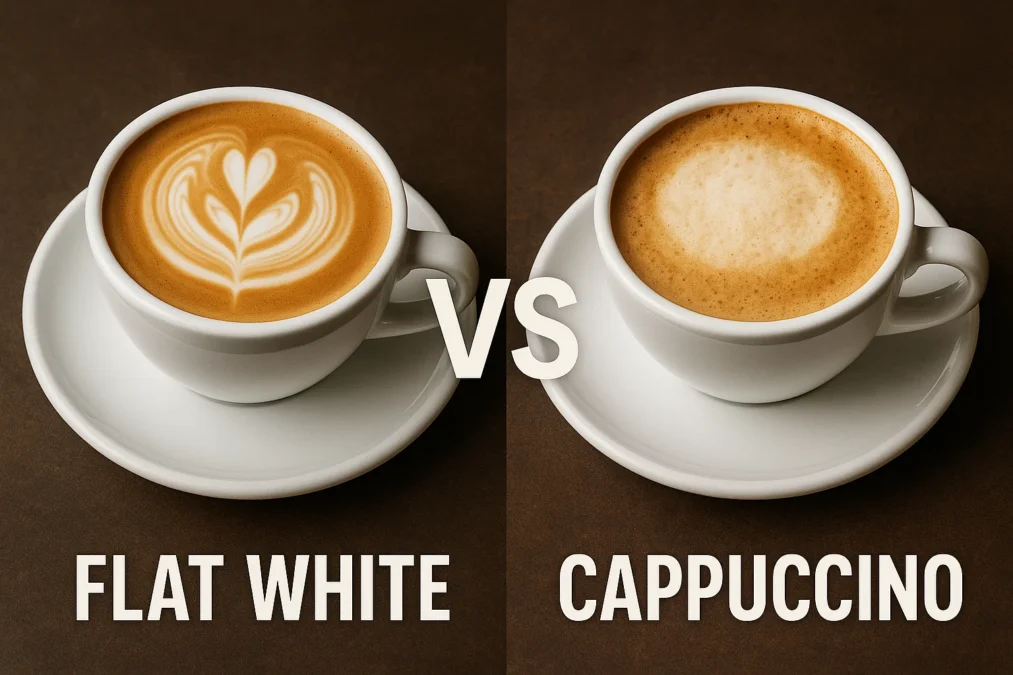You’re standing at the counter of your favorite coffee shop, ready to order. You want something espresso-based and milky, but the menu presents a familiar dilemma: flat white vs cappuccino. They both involve espresso and steamed milk, so how different can they really be? To the untrained eye, they might look like siblings, but in the world of coffee craftsmanship, they are distinct personalities with unique histories, textures, and flavor profiles. This isn’t just a minor preference; it’s a fundamental difference in coffee philosophy. Understanding the nuances between a flat white and a cappuccino is your key to ordering with confidence and truly appreciating the art in your cup. This guide will take you on a deep dive into the origins, the science of milk, the cultural contexts, and the sensory experiences that define these two beloved beverages. By the end, you’ll not only know what sets them apart, but you’ll also know exactly which one to order to match your mood and craving.
The Tale of Two Coffees: A Journey from Italy to Australia and Back
Every great coffee drink has a story, and the histories of the cappuccino and the flat white are as different as their textures. The cappuccino is the old-world classic, steeped in European tradition. Its name is believed to be derived from the Capuchin friars, a 16th-century offshoot of the Franciscan order, whose distinctive brown robes matched the color of the coffee drink. The modern cappuccino as we know it—a triple-layered masterpiece of espresso, steamed milk, and a thick dome of foam—was perfected in Italy post-World War II, with the widespread adoption of the espresso machine. It became the cornerstone of Italian café culture, a drink to be consumed quickly while standing at a bar, often only in the morning. Its structure is rigid, a testament to a time-honored formula.
The flat white, on the other hand, is the modern upstart, a product of the vibrant and innovative coffee scene that blossomed in Australia and New Zealand in the 1980s. The exact origins are hotly contested between the two nations, a friendly rivalry that continues to this day. Whether it was first poured in Sydney or Auckland, the flat white was a direct response to the desire for a coffee that showcased the espresso more prominently than the increasingly foam-heavy cappuccinos and lattes of the time. It was designed for the new wave of specialty coffee, where the quality of the espresso shot was paramount and needed to be balanced, not buried. This drink crossed oceans and conquered the global coffee scene, becoming a staple in third-wave coffee shops from London to Los Angeles, symbolizing a shift towards a more nuanced and espresso-centric milk coffee.
Deconstructing the Drink: It’s All About the Milk
At the heart of the flat white vs cappuccino debate lies one simple, yet complex, ingredient: milk. How the milk is aerated, steamed, and textured is the single greatest factor that defines the character of each drink. The process is both a science and an art, requiring skill and precision from the barista. When steam is introduced to milk, it does two things: it heats the liquid and it injects tiny air bubbles, a process called aeration. The amount of aeration and how the barista manipulates the milk pitcher determines the final texture, from the velvety microfoam of a flat white to the billowy, airy foam of a cappuccino. This textural difference is not just a mouthfeel; it directly influences how the coffee flavor is delivered to your palate.
For a cappuccino, the goal is to create a distinct separation between the liquid milk and the foam. The barista will introduce more air early in the steaming process, creating a larger volume of stiff, dry foam that sits distinctly on top of the drink. In a traditional preparation, this results in a clear three-layer structure: one-third espresso, one-third hot milk, and one-third milk foam. A flat white demands a completely different technique. The barista aims for minimal aeration, focusing instead on tearing and spinning the milk to create a seamless, homogenous liquid known as microfoam. This microfoam is silky, glossy, and fully integrated, with tiny, invisible bubbles that give it a dense, paint-like consistency. There are no separate layers; the microfoam is the drink from top to bottom.
The Anatomy of a Cappuccino
A cappuccino is a drink of structure and tradition. Its identity is built on a specific and deliberate ratio. The classic formula is an equal-part trinity: one shot of espresso, one part steamed milk, and one part thick milk foam. This structure creates a multi-sensory experience. Your first sip might be predominantly airy foam, which then gives way to the warmer, liquid milk and espresso beneath. The foam acts as a natural insulator, keeping the drink hot while also providing a light, sweet, and creamy textural contrast to the robust espresso below. The experience evolves with every sip, as you journey through the layers from the top of the foam down to the last drop of espresso at the bottom.
The texture of a properly made cappuccino foam is key. It should be dry enough to support a sprinkle of cocoa powder or cinnamon without immediately sinking, but not so stiff that it feels like meringue. When you take a sip, the foam should feel light and pillowy on your upper lip. The flavor profile of a cappuccino is a balance between the intensity of the espresso and the sweetness of the milk. The foam itself, being mostly air, delivers a concentrated milky sweetness, while the underlying liquid provides the coffee punch. This makes the cappuccino a perfect choice for those who enjoy a textural play in their drink and appreciate the way the milk’s sweetness can complement, rather than dominate, the espresso.
The Anatomy of a Flat White
If the cappuccino is about layers, the flat white is about integration and intensity. The ratio is fundamentally different. A flat white typically uses a double shot of espresso as its foundation, paired with a smaller volume of milk. However, the critical component is that this milk is almost entirely microfoam. There is no separate layer of foam sitting on top; the entire milk portion of the drink is velvety and liquid. This results in a stronger coffee flavor, as the higher espresso-to-milk ratio and the seamless integration allow the nuances of the coffee beans to shine through without being diluted by a large volume of liquid milk or masked by a thick layer of airy foam.
The mouthfeel of a well-crafted flat white is its most defining characteristic. The microfoam should be so smooth and finely textured that it feels like liquid silk. It has a certain weight on the tongue that is absent in a cappuccino. This dense texture also allows for the barista’s pièce de résistance: latte art. The pourability of microfoam enables the creation of intricate rosettas, tulips, and hearts on the surface of the drink, a visual guarantee of the quality within. When you drink a flat white, you get a consistent flavor and texture from the first sip to the last. It’s a cohesive, rich, and coffee-forward experience designed for those who want to truly taste the espresso.
The Ultimate Showdown: Latte vs Cappuccino, Deciphered
The Flavor and Mouthfeel Experience
Closing your eyes and taking that first sip is where the flat white vs cappuccino distinction becomes truly apparent. The flavor experience of a cappuccino is one of progression and contrast. Initially, you are met with the sweet, light, and airy sensation of the foam. It’s a gentle introduction that prepares your palate. As you drink deeper, the warmer, more liquid mixture of milk and espresso comes forward, offering a creamier and more robust coffee flavor. The separation of elements means each part of your sip can taste slightly different, creating a dynamic and evolving experience that is both comforting and stimulating.
In contrast, the flat white offers a unified and intense flavor journey from the very beginning. Because the microfoam is fully integrated, there is no layered progression. Instead, you are immediately greeted with a powerful, silky wave of coffee. The mouthfeel is consistently dense, creamy, and smooth throughout the entire drink. The smaller volume of milk and the double shot of espresso mean the coffee notes are more pronounced, allowing you to detect the chocolatey, nutty, or fruity characteristics of the beans themselves. The microfoam carries the espresso’s flavor evenly, coating your palate in a rich, velvety blanket. It’s a less sweet, more serious coffee drink for those who want clarity and strength.
A Visual and Textural Comparison
Even before you take a sip, your eyes can tell you a lot about what’s in your cup. A traditional cappuccino is served in a larger, often wider cup to accommodate its voluminous foam head. The dome of white foam rises distinctly above the rim, often dusted with chocolate or cinnamon, creating a clear visual separation. When you tap the cup, the foam might jiggle as a separate entity. It looks inviting and comforting, a classic image of a milky coffee. The spoon test is a classic differentiator; in a cappuccino, you can often scoop up a spoonful of the stiff foam.
A flat white, by its very nature, has a much flatter appearance—hence the name. It is served in a smaller, typically ceramic cup, similar to a 5-6 ounce Gibraltar glass. The surface is sleek and glossy, adorned with a layer of latte art. There is no domed foam; the liquid comes right to the brim with a smooth, brown-and-white design on top. The visual cue is one of sophistication and modern craft. Texturally, if you were to dip a spoon into a flat white, it would simply be coated in the silky liquid; there is no separate foam to scoop. This visual and textural minimalism is the hallmark of the drink.
The Global Evolution and Cultural Impact
The journey of these two drinks from their origins to the global stage is a fascinating study in cultural exchange. The cappuccino traveled from Italy and became a worldwide symbol of European café culture. For decades, it was the default choice for anyone wanting a frothy coffee drink. Its definition, however, has become somewhat blurred in many parts of the world, especially in large chains where a “cappuccino” might simply mean a latte with extra, often dry and lackluster, foam. This dilution of the classic standard is part of what inspired the creation and rise of the flat white, which brought with it a renewed focus on milk texture and espresso quality.
The flat white acted as a catalyst in the global third-wave coffee movement. It educated a new generation of coffee drinkers about the importance of microfoam and a balanced ratio. Its popularity forced baristas everywhere to hone their milk-steaming skills to a higher level. The drink became so ubiquitous that it was eventually adopted and popularized by major global chains, cementing its place in the coffee lexicon. This global adoption has also led to some regional variations. In some cafes, you might find a flat white that is very similar to a small latte, while others adhere strictly to the velvety microfoam and strong coffee ratio. Despite these slight variations, the core principle of a flat white remains: a strong, smooth, and integrated coffee experience.
Crafting the Perfect Cup at Home
The rise of high-quality home espresso machines has made it possible for enthusiasts to explore the flat white vs cappuccino challenge in their own kitchens. The key to success, as in a professional café, is mastering the milk. For a cappuccino, you need to aerate the milk a little longer—listening for a distinct “chirping” or “paper tearing” sound for a few seconds—to build up that volume of foam. After steaming, you can even give the pitcher a few firm taps on the counter and a swirl to help separate the denser foam from the liquid milk, making it easier to spoon onto your espresso.
Creating a true flat white at home is the ultimate test of a home barista’s skill. It requires a much more delicate touch. You want to introduce only a tiny amount of air—just a quick “psst” sound—before immediately submerging the steam wand tip to create a whirlpool in the pitcher. The goal is to heat the milk while stretching it just enough to create that homogenous, velvety microfoam without any large bubbles. The pour is also critical; you need to integrate the milk and espresso smoothly from the start, aiming for a seamless blend that allows you to finish with a defined dot of white or a simple heart of latte art. It takes practice, but achieving that silky texture is immensely rewarding.
Which One Is Right for You?
So, after this deep dive, how do you choose in the great flat white vs cappuccino debate? Your decision ultimately comes down to what you value most in your coffee experience. If you are in the mood for a classic, comforting drink with a playful texture and a balanced, evolving flavor, then the cappuccino is your perfect match. It’s the ideal morning companion or a delightful treat when you want to feel the contrast between the airy foam and the warm coffee beneath. It’s a drink that doesn’t take itself too seriously and offers a familiar, cozy experience.
If your priority is a strong, coffee-forward beverage with a luxurious, smooth mouthfeel from start to finish, then the flat white is unequivocally your drink. It is the choice for the espresso purist, for when you want to savor the specific tasting notes of a high-quality bean without interruption. The flat white is a modern, sophisticated choice that highlights the skill of the barista and the quality of the ingredients. It’s less about comfort and more about a refined, intense coffee hit. Understanding this fundamental difference empowers you to select the perfect drink for any occasion, time of day, or personal craving.
Comparison Table: Flat White vs Cappuccino
| Feature | Flat White | Cappuccino |
|---|---|---|
| Origin | Australia/New Zealand (1980s) | Italy (Post-WWII) |
| Ratio | Double Espresso + Small Volume of Microfoam | Equal Parts Espresso, Steamed Milk, Foam |
| Milk Texture | Velvety, Integrated Microfoam (liquid) | Distinct, Thick, Airy Foam layer |
| Serving Size | Smaller (5-6 oz / 150-180 ml) | Larger (6-7 oz / 180-200 ml) |
| Flavor Profile | Strong, Espresso-Forward, Less Sweet | Balanced, Milky, Sweet from Foam |
| Mouthfeel | Smooth, Silky, Dense | Light, Pillowy, Evolving |
| Visual Appearance | Flat, with Latte Art | Domed Foam Head, often dusted |
| Ideal For | Espresso lovers, strong & smooth coffee | Textural variety, a classic milky coffee |
Quotes from the Coffee World
“A cappuccino is a conversation between espresso and milk, with foam as the moderator. A flat white is an espresso monologue, with milk as its eloquent supporting actor.” – Anonymous Master Barista
“The flat white didn’t invent microfoam, but it taught the world to demand it.” – Coffee Culture Historian
“In Italy, a cappuccino is a morning ritual. In Melbourne, a flat white is an all-day affirmation.” – Global Coffee Shop Owner
Conclusion
The journey through the world of flat white vs cappuccino reveals that these are two distinct pillars of coffee culture, each with its own proud history, precise craft, and dedicated following. The cappuccino, with its structured layers and airy foam, offers a timeless and comforting experience that celebrates the contrast between milk and coffee. The flat white, a modern classic, champions integration and intensity, delivering a silky, coffee-forward punch that highlights the quality of the espresso. One is not inherently better than the other; they are simply different answers to the question of how we enjoy our milk and coffee. The next time you find yourself at that coffee counter, you can listen not just to your craving, but to your newfound knowledge. Whether you choose the textured tradition of the cappuccino or the velvety strength of the flat white, you will be sipping on a drink with a rich story, made with purpose and passion.
Frequently Asked Questions
What is the main difference between a flat white and a cappuccino?
The main difference lies in the texture and ratio of the milk. A cappuccino has a distinct structure with equal parts espresso, steamed milk, and thick, airy foam, resulting in a layered drink. A flat white features a double shot of espresso and a smaller volume of velvety microfoam that is fully integrated, creating a stronger, smoother, and more cohesive beverage from the first sip to the last.
Is a flat white stronger than a cappuccino?
Yes, typically a flat white has a stronger coffee flavor. This is because it is made with a double shot of espresso and a smaller overall volume of milk compared to a cappuccino. The integrated microfoam also does little to dilute the espresso, allowing its robust flavor to dominate. In a cappuccino, the larger milk volume and thick foam layer can mellow out the coffee’s intensity.
Which has more milk, a flat white or a cappuccino?
A cappuccino generally has a larger total volume and more liquid milk than a flat white. However, a significant portion of a cappuccino’s volume is dedicated to its dry foam. A flat white uses less total milk, but that milk is entirely in the form of dense, liquid microfoam, so it has a richer and creamier mouthfeel despite the smaller quantity.
Can I make a flat white or cappuccino at home without an espresso machine?
While it’s challenging to achieve authentic texture without a steam wand, you can create approximations. For a cappuccino, you can heat and froth milk using a French press (pump the plunger) or a handheld frother, spooning the foam over strong coffee. For a flat white, the goal is less foam; heat the milk and use a frother briefly, then swirl the pitcher to integrate the bubbles as much as possible before pouring into a small, strong coffee. The results won’t be perfect, but they can be enjoyable.
Why is my flat white sometimes served in a glass?
Many modern coffee shops, especially those in the third-wave style, serve flat whites in a Gibraltar glass, which is a short, sturdy tumbler. This is partly a stylistic choice that allows the customer to see the color and consistency of the drink, and it also pays homage to the drink’s modern and craft-oriented roots. The small size of the glass is perfect for the typical 5-6 ounce serving of a flat white.
Which drink is better for latte art, a flat white or a cappuccino?
The flat white is unequivocally the better canvas for latte art. The seamless, pourable microfoam is essential for creating defined patterns like rosettas and tulips. The thick, dry foam of a traditional cappuccino does not allow for the intricate pouring required for latte art; at best, you might get a simple design, or baristas will dust the top with cocoa powder in a stencil pattern.



